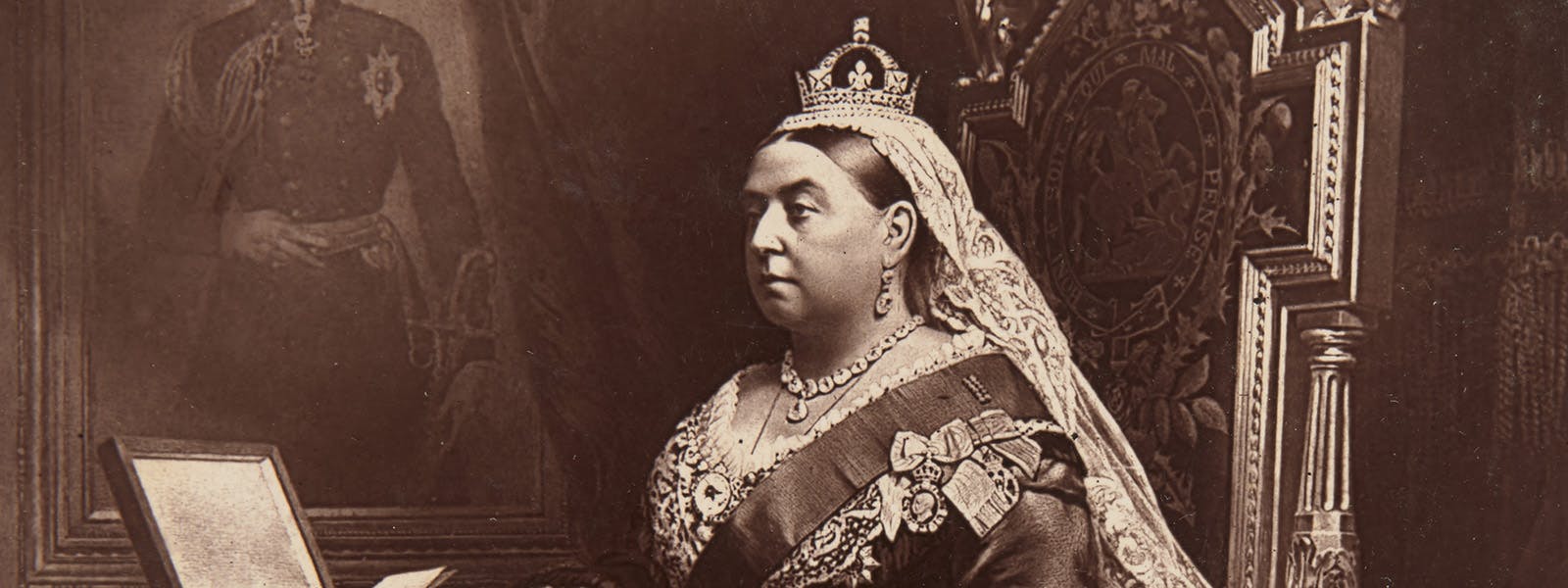
About Victoria's Self Fashioning
This project concluded in June 2019
Queen Victoria's name is used to identify an era. Over her long reign the British Empire covered a quarter of the globe. The birth of photography, and an explosion in print culture and the press, allowed her image to touch its furthest reaches. Her image, painted and sculpted, still dominates public spaces scattered throughout every continent.
However, narratives of Victoria’s life tended to set her up as a curiously inert figure, detached from public life and politics. This project challenged these orthodoxies by examining Victoria as a pro-active political agent in the construction of an image for nineteenth century monarchy, and therefore directly implicated in what would become the Queen Victoria phenomenon.
Masthead Image: portrait of Queen Victoria (1837-1901) commissioned for her Diamond Jubilee in 1897. © Historic Royal Palaces.
Aim of the project
The principal aim of ‘Victoria’s Self-Fashioning’ was to establish an international research community of scholars from a wide range of disciplinary and institutional bases, to re-appraise Victoria's approach to her role and to engage in a common curation of its material legacy. The project formed part of the research undertaken to mark the 2019 bicentenary of Victoria's birth at Kensington Palace, an opportune moment to assess the myths that commonly circulate about her.

Image: The Graphic, 1 June 1897. The front cover bears an illustration of Queen Victoria around the time of her accession and is subtitled 'The Queen's Diamond Jubilee number'. © Historic Royal Palaces
Research questions
The research network explored key research areas and questions facilitated by three workshops:
1. The many Victorias - Exploring Victoria's curation of herself
The first workshop centred on Victoria's creation of her own image and the ways in which she managed her conflicted role, as a Queen Regnant, but also a wife and mother. Through considering her surviving dress, the royal photographic collection, and Victoria's own amateur art works, it assessed how this image was tested, honed, and developed by her, to serve the needs of the monarchy over the seventy-four years of her reign.
This workshop also explored how Victoria, as curator, presented the material of her life, for a public audience, in the first museum displays in her celebration, and how these were received.
2. Private sphere to public realm - Mapping the journeys of Victoria's image
The second workshop mapped the journey of this self-curated image from Victoria's private sphere to the public realm, and particularly across the British Empire. Participants explored her involvement in the commissioning and purchase of painted, sculpted and photographic images to celebrate her family and its dynastic ambition.
Researchers also investigated the dissemination of these images through burgeoning print culture, and their movement and use both locally and globally.
3. Curating Queen Victoria – A global figure in a digital world
The third workshop focused on how the image of Victoria might be curated today in the digital sphere, asking how this material can be made available not only to scholars but to a wide, global public? The focus of this activity was to devise ways in which a project can be undertaken across a number of institutions around the globe, providing a methodological and practical template for further research.
The workshop considered ways in which the 'digital museum' can challenge the notion of the physical ownership of the material culture associated with this globally important figure and can allow curation by a wider and more diverse audience.

Image Caption: Postcard depicting the late Queen Victoria (1837-1901) holding a fan. © Historic Royal Palaces
Outputs and findings
Publications
- Marschner, J., and Hatt, M., (eds), Nineteen: Studies in the Long Nineteenth Century, Queen Victoria’s Self-fashioning: Curating the Royal Image for Dynasty Nation and Empire, 33 (2022).
- Marschner, J., Homans, M., and Munich., A (eds), Leaves of the Journal of Our Life in the Highlands, and More Leaves (Oxford: Oxford University Press, 2024).
PhD studentships
- Catriona Wilson, ‘The Visual Aging of Queen Victoria and her Authorised Public Image’ (University of Warwick and Historic Royal Palaces, 2023).
- Gabrielle Fields, ‘Queen Victoria’s Library’ (University of Exeter and Historic Royal Palaces, in progress).
Workshops and conferences
- Three project workshops and a conference were delivered as part of the project which brought scholars together from Europe, India, Australia, Canada, and the US.
- Joanna Marschner and Michael Hatt were invited to be part of Taj of the Raj: reassessing the histories of the Victoria Memorial Hall, Kolkata, an international research group led by the Victoria Memorial Hall, Kolkata, Yale University, and Syracuse University. This participation consisted of the attendance at three workshops and the delivery of three lectures, including one in Kolkata.
- A workshop on the project was delivered through the Centre for the Humanities, University of Oxford, for undergraduates, postgraduates and staff members.
- A series of workshops were held with the German Embassy London, to coordinate and align academic and heritage anchored events marking the 200th anniversary of Queen Victoria’s birth.
- The project team also contributed to the V&A’s in-house workshops which were a framework for marking of the Queen Victoria 200 anniversary within the museum, together with building redevelopment planning.

Image: Engraving depicting Queen Victoria (1837-1901) at her coronation in 1838. © Historic Royal Palaces
Public engagement
- Wrote proposal and provided research for a TV programme on Queen Victoria and music. Completed 2019.
- Provided research to underpin Kensington Palace exhibition, Queen Victoria: Woman and Crown.
- Provided research, inspiration, and assistance with Bright Nights series of evening salons, Kensington Palace, exploring Queen Victoria, female agency, Britain in the world (2019).
Research team
Principal Investigator: Dr Joanna Marschner (HRP)
Co-Investigator: Prof. Michael Hatt (University of Warwick)
Funder
This project was funded by the Arts and Humanities Research Council’s Research Networking scheme.

